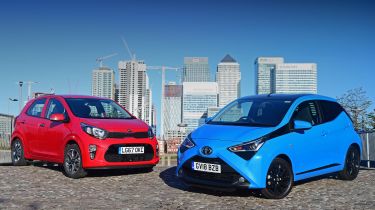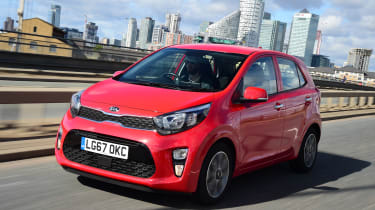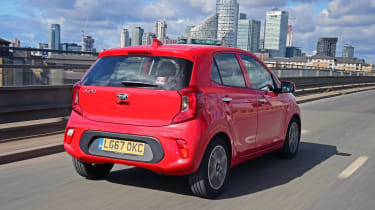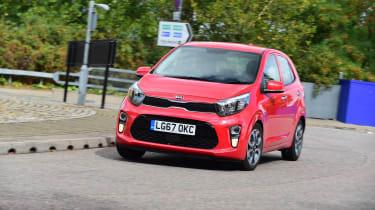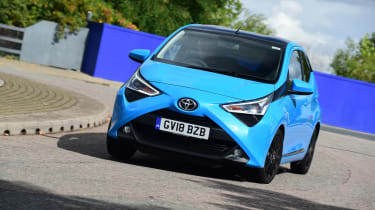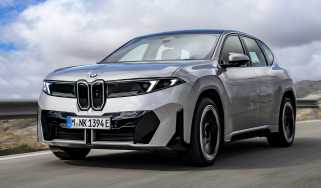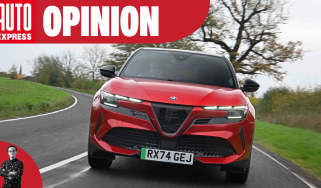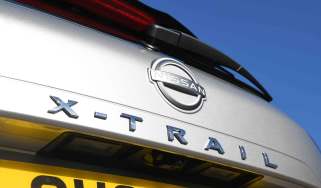Toyota Aygo vs Kia Picanto: a used cheap city car shootout
The Toyota Aygo takes on the Kia Picanto in a used five-door city car shootout
Car buyers have been downsizing for a while now, for two key reasons. Firstly, they want to cut their motoring costs, and secondly, buying one of the smallest vehicles on the market no longer necessarily means compromises when it comes to equipment levels, build quality, comfort or safety.
Performance doesn’t necessarily take a hit either, and because these are the smallest and lightest cars around, they’re invariably agile and good fun to drive. The problem is that profit margins are tight, and regulations mean that by the time essential safety and emissions-limiting kit have been installed, some car manufacturers have found that their margins are paper thin. And that’s if there’s any profit to be made at all.
The result has been a big reduction in the number of new city cars available, which ultimately means there will be slimmer pickings on the used market. With demand as high as ever for these cars, values have been going up rather than down, especially for the best examples out there. Two of the finest examples in the class include this pair from Toyota and Kia. Both are available in big numbers, and both are very desirable for a multitude of reasons. But where should you put your cash?
Toyota Aygo
- Prices from £4,000 (Toyota Aygo 1.0 x-play 2014, 80k miles)
- For: Reliability is excellent. This is one distinctive-looking city car that has very user-friendly infotainment.
- Against: The insurance group is a bit steep, it’s not as much fun to drive or as comfortable as the Kia. There is only one engine option.
Also sold as the Citroen C1 and Peugeot 108, the Aygo was made on the same production line as its cousins, but it has a more daring design than them – and the Picanto, too. It also has a more wide-ranging and impressive infotainment system, while its dash design has a little extra flair. But it isn’t quite as user-friendly, so you might prefer it – or you might not. Our vote goes to the Kia in this regard.
Used - available now

2025 Suzuki
S-Cross
12,284 milesAutomaticPetrol1.5L
Cash £16,700
2020 Jaguar
I-PACE
42,451 milesAutomaticElectric
Cash £16,400
2019 BMW
X1
107,352 milesAutomaticDiesel2.0L
Cash £9,699
2020 Volkswagen
Tiguan
57,402 milesAutomaticDiesel2.0L
Cash £20,300The Toyota is also something of a mixed bag dynamically. Although it feels more agile than the Kia, its ride isn’t as well resolved. And while the Aygo has more power, its higher gearing blunts its performance, which is really rather slow when you’re trying to accelerate on the move. To make good progress you have to row it along working the gears hard, but at least the Toyota’s steering is sweeter than the Kia’s. What’s not so good, however, is that at higher speeds there’s more road roar.
With the Aygo arriving well before the Picanto, you can buy one for a lot less. Just £4,000 buys an early (2014 or 2015) example, while 2017 cars with 50,000 miles on the clock are priced from around £5,000.
Kia Picanto
- Prices from £6,000 (Kia Picanto 1.0 1 2017, 70k miles)
- For: The Picanto has a more grown-up interior design with higher quality, it’s better to drive, and roomier, too.
- Against: It looks and feels a bit staid compared with the Aygo, and its steering isn’t as sweet. Prices start higher, too.
When the Picanto Mk2 arrived in 2011, it was such an improvement over the Mk1, and such a talented city car, that it made things very hard for Kia when it came to creating the Mk3. Sure enough, that Picanto wasn’t such a big advance, but that was no problem, because it still had a grown-up feel. We tested the Mk3 in entry-level 1.0-litre form, which was perfect for new drivers due to its low insurance group and relatively cheap running costs, while those diminutive proportions make it easy to park.
The downside is the relatively leisurely performance, but the Picanto is nippier than the Aygo thanks to its shorter gearing – and despite this, at motorway speeds the Kia is more refined than the Toyota and it also has a more comfortable ride. Throw in a more mature cabin and the Picanto impresses, despite its tiny size.
Even better, you don’t need deep pockets to buy a Picanto, although proportionally, these tiddlers have held onto their value better than many bigger cars. You’ll still need at least £6,000 to buy an early Picanto 1.0, with automatics costing from £8,000.
Which one should you choose?
1st: Kia Picanto
Not only does the Picanto have a roomier cabin, but it’s also more refined. The perkier acceleration makes the Kia more relaxing to drive, and it’s more comfortable, too.
2nd: Toyota Aygo
The Aygo looks more distinctive and has better infotainment. Top reliability is also a plus, although the Toyota’s breadth of talents isn’t as great as the Picanto’s.
Toyota Aygo vs Kia Picanto new car test: September 2018
Below is our original twin test of the Picanto and the Aygo as published in 2018. All information correct at time of publication...
Fighting through traffic jams, width restrictors and complex junctions and avoiding selfish driver are all part of commuting in a big city. The recently updated Toyota Aygo and Kia Picanto are built specifically for the task of dealing with daily city drives.
City cars are truly built for the task, but they’re also great in many other ways. They’re cheap to buy and run, fun to drive and often have plenty of personality. They might be built down to a price, yet the best cars in this class have a wide range of ability, so its not just those who live in cities who love them. They’re a favourite with young drivers for their low insurance costs, but which of these two is better?
Head-to-head
| Model: | Toyota Aygo1.0 VVT-I x-press | Kia Picanto 1.0 Mpi '2' |
| Price: | £12,630 | £11,075 |
| Engine: | 1.0-litre 3cyl petrol | 1.0-litre 3cyl petrol |
| Power/Torque: | 71bhp/93Nm | 66bhp/96Nm |
| Transmission: | Five-speed manual,front-wheel drive | Five-speed manual,front-wheel drive |
| 0-60mph/Top Speed: | 13.2 seconds/99mph | 12.4 seconds/100mph |
| Test Economy: | 53.2mpg/11.7mpl | 49.8mpg/10.9mpl |
| CO2/Tax: | 93g/km/£140 | 114g/km/£140 |
| Options: | Metallic paint (£515),smartphone Integration (£200) | None |
Kia Picanto
The latest Kia Picanto is the best version yet, having been redesigned to add more space, technology and a relatively wide range of engine options for a city car. It’s the 66bhp 1.0-litre model we’re testing here, which is the entry-level motor, aimed at those wishing to save on running costs and especially insurance premiums if they are young drivers.
The three-cylinder engine is smooth and fun to use, although it’s not as peppy as the Aygo’s 71bhp unit. However, shorter gearing means it is significantly more flexible than the Toyota.
In our performance tests the Kia was 0.8 seconds faster than the Aygo from 0-60mph, but it also performed strongly in gear. While its rival took a glacial 14.1 seconds to cover 30-50mph in fourth, the Picanto posted a more reasonable time of 9.5 seconds. Neither of these cars will set the tarmac alight with their performance potential, but the Picanto’s extra pace is very welcome here.
Long gearing in the Aygo helps improve official economy and keep the revs down at a cruise, but it wasn’t significantly more efficient than the Kia. And even though the Picanto sits at higher revs at 70mph than the Toyota, the Korean model is quite quiet inside at speed, too, so it’s the better choice for motorway trips.
It’s not just on high-speed roads that the Kia feels at home, since the comfortable ride soaks up potholes and poor surfaces at low speeds around town as well. It’s more refined than its competitor here in pretty much every situation. The steering isn’t quite as positive as the Toyota’s, but it is reasonably well weighted, and the Picanto is fun to drive as well. The gearchange is light and has a mechanical feel, so it’s satisfying if not really enjoyable to use.
Interior quality in the Kia is on par with that in the Toyota, but neither car is a class leader here. Both feature hard, cheap plastics in abundance, which is to be expected in this class. The pair has different takes on interior design, with the Kia’s being more restrained but a little classier as a result, while the Aygo has funkier styling; much like the exteriors of each car. The Kia is more reserved, the Aygo is more extroverted.
In ‘2’ trim the Kia Picanto comes with 14-inch alloy wheels, a leather-trimmed steering wheel with controls for the audio system, cruise control, air-conditioning and a monochrome radio display. There’s also Bluetooth included, but if you want a colour touchscreen you’ll have to upgrade to ‘3’ or X-Line specification.
Testers Notes
- Materials: Cheap materials are par for the course in the city car class, but at least both of these rivals feel well built and robust
- Steering Wheel: Media controls on the wheel mean it’s easy to control while on the move. The steering itself is light and makes the car easy to drive
- Technology: Picanto in ‘2’ trim comes with a USB port and Bluetooth, but no touchscreen. You will need to pick a more powerful engine variant to get this feature included as standard
Toyota Aygo
The first thing you’ll notice about the Toyota Aygo is its distinctive exterior design. It’s one of the best-looking cars in its class, and is much more visually interesting than the comparatively bland Kia. The recent facelift added LED daytime running lights and LED tail-lamps to give it an even more modern look. It’s a similar story on the inside, although some people will prefer the more grown-up and reserved design of the Picanto.
An infotainment display is the biggest advantage the Toyota has over its rival. The Kia only has a tiny monochrome display in ‘2’ trim, but the Aygo x-press features a touchscreen system with Bluetooth, DAB and a reversing camera. You can add sat-nav for £400, too; this isn’t available unless you buy a higher trim level on the Kia. Go for x-press trim and you can add Apple CarPlay and Android Auto functionalityas part of a £200 pack, something that’s been missing from Toyota’s products until recently (it’s also available on some Picanto models).
The Toyota is slightly more agile than its rival, with well-weighted steering, even if the damping doesn’t feel as sophisticated. You can hurl the Aygo into corners and feel it shuffle its weight on the road surface, which is at least good fun. Also, the engine has been updated with more power, so it now has 71bhp. It retains its engaging character, because it sounds characterful, even if it’s short on performance.
Hampering the Aygo’s keen engine are the tall ratios of the gearbox, and you’ll need to drop one or more gears to accelerate at all quickly. It took 10.2 seconds to go from 30-50mph in third, where the Kia only took 6.3 seconds.
That gives you an idea of its performance deficit; you’ll often be in third as you accelerate from a village out into a national speed limit zone or dual carriageway. The thrummy engine means it’s actually quite fun to accelerate in the Aygo, but there’s an extra element of frustration as you put your foot down and nothing much happens for several seconds while the revs build.
The sweet handling also has a trade-off in that the Aygo feels more brittle on the road than its rival. It’s fine once you’re up to speed, but doesn’t deal with potholes and broken surfaces quite as well as the Picanto. This means the car bounces around more on tight city streets. It’s a bit noisier on the motorway than the Kia, too, and the weak engine means you feel less confident with overtaking on fast roads.
Testers Notes
- Colour: Painted panels are on show inside, which is ypical for many city cars. It adds extra colour to the cabin
- Dashboard design: Aygo’s dashboard looks more interesting than Kia’s, but still feels cheap. While Picanto’s is more plain, it’s classier
- Touchscreen: Screen on our test car included smartphone integration, a must-have for many city car buyers. It’s a welcome addition to the Toyota
Verdict
First place: Kia Picanto
The Picanto is stronger in several key areas than its rival, so it’s the better buy. The Kia is more spacious inside, quieter and, thanks to its stronger performance, it’s more relaxing to drive. It rides well and is great value, both outright and on PCP finance, and boasts more usability.
Second place: Toyota Aygo
The Aygo is stylish, economical and fun to drive but loses out here. It’s more cramped, is less comfortable and its performance disappoints, even with more power than before. The facelift has improved its appeal, but not by enough to beat the more practical Kia.
